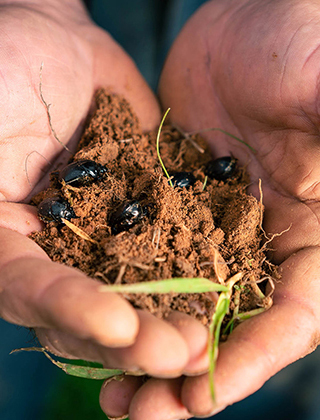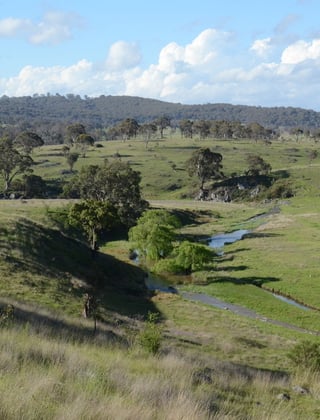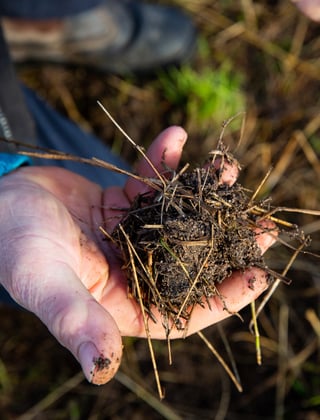Colin Seis, 'Winona', Central Tablelands

Woolgrower and pasture cropping pioneer Colin Seis is coping with the drought with perennial grassland and regenerative agricultural practices.
The property of woolgrower and pasture cropping pioneer Colin Seis from Gulgong in the Central Tablelands of NSW is coping with the drought better than a lot of other farms in the region, which he attributes to his perennial grassland and regenerative agricultural practices.
Colin Seis and his son Nick run 3,500 Merinos, grow cereal crops and harvest native grass seed on the family’s 840 ha property ‘Winona’ 20km north of Gulgong. The property also runs the ‘Winona’ Merino stud, and is one of the largest breeders of Kelpie dogs.
The average annual rainfall is 650mm, but they have seen less than half that for the past two years due to the drought conditions that have affected many farms across eastern Australia.
While many properties in NSW have been relying on fodder from interstate and handfeeding of stock, Colin has been supplementary feeding grain and minerals to his sheep, however most of the feed has come from his native perennial grassland pastures for sustaining his flock during drought.
“It’s been very dry here this year, just like many parts of the state, and while the farm isn’t going as well as it normally would, our grassland pastures have been very resilient and responded well when we have had the little bit of rain,” Colin said.
“Following a storm in February, we had green pasture in summer and autumn; when the summer-growing native grasses became dormant in winter it became standing dry feed. This pasture feed is good quality and the sheep are doing well on it – while we are supplementing with a bit of protein, some urea and a little bit of grain, leading up to lambing.”
The benefit of native grassland was evidenced in this year’s September shorn wool clip. The sheep cut around the same amount of wool as previous years. Its yield was around seventy percent, and tested sound, with results of 40-45 Nkt.
A BIT OF HISTORY
The Seis family has farmed at Winona since the 1860s. Ranging from valley floors and gentle slopes rising to granite outcrops on hilltops and ridges, the predominant soils on Winona are well-drained coarse and fine sands derived from granite.
From the 1930s to 1980, the farm was used for wheat, oats, wool and sheep production. Pastures of introduced grasses, mostly annual species (sub clover, rye grass, small areas of lucerne), were established. Set or continuous stock grazing practices were used. Crops were sown every three to five years by ploughing and working the soil up to five times. Crop yields during this period were good, achieving more than three tonnes per hectare.
However, Colin says to sustain agricultural productivity it was necessary to apply high rates of fertiliser to correct phosphorus, molybdenum and calcium deficiencies.
“While superphosphate was cheap and subsidised by government during the 1950s and 1960s this high input method was very productive,” he said. “However, as superphosphate became more expensive and the government subsidy was removed, this high input system was no longer affordable.”
Colin goes further and says the management of Winona from 1930 to 1980 turned out to be an ecological disaster.
“Loss of land to salinity, declining soil structure and quality, soil carbon loss, dead and dying trees, insect attack, fungal and animal diseases, plus the high cost of fertilisers, herbicides and other inputs showed the suffering of an unhealthy system.”
In 1979 a devastating bushfire ran through the property destroying the farm’s infrastructure and livestock. This meant that a lack of income prevented Colin re-establishing the previous high input cost cropping method and he was left with no choice but to change the way farming was done on Winona.
PASTURE CROPPING
During the next 20 years, Colin and his neighbour Daryl Cluff developed a new technique they call ‘pasture cropping’ that involves sowing crops into living perennial pastures and growing them in combination, so that the cropping and grazing benefit each other.
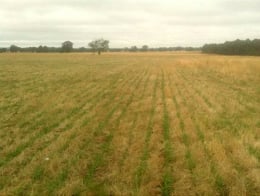 Emerging green grain seedlings in dormant perennial pasture.“Pasture cropping enables integration of sheep and crop production, optimising production of both while minimising chemical inputs and machinery use and improving soil structure and fertility,” Colin said.
Emerging green grain seedlings in dormant perennial pasture.“Pasture cropping enables integration of sheep and crop production, optimising production of both while minimising chemical inputs and machinery use and improving soil structure and fertility,” Colin said.
“While conventional cropping methods require that all vegetation be killed prior to sowing and while the crop is growing, with pasture cropping there is no need to kill competing ground cover vegetation, and yet adequate productivity can still be achieved.
“Groundcover is maintained at all times which makes the paddocks more resilient to drought, wind and water erosion are avoided, soil structure is not destroyed by cultivation, and chemical input requirements are only a fraction of those used in traditional crop production methods.”
Sowing a crop using the pasture cropping method also stimulates a diverse variety of perennial grass seedlings, which sit dormant in the soil, to grow in high numbers. This then produces more stock feed after the crop is harvested and eliminates the need to re-sow pastures.
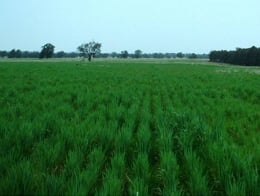 The grain crop growing in the pasture.“Economically, this technique provides good potential for profit as input costs are substantially less than conventional cropping methods. The added benefit in a mixed farm situation is that up to six months extra grazing is achieved with pasture cropping as no grazing time is lost due to traditional ground preparation and weed control requirements.”
The grain crop growing in the pasture.“Economically, this technique provides good potential for profit as input costs are substantially less than conventional cropping methods. The added benefit in a mixed farm situation is that up to six months extra grazing is achieved with pasture cropping as no grazing time is lost due to traditional ground preparation and weed control requirements.”
Colin has spent many years perfecting this technique and can now grow many different types of winter and summer growing crops on Winona, without destroying the perennial pasture base.
He now sows commercial crops into the dominant pasture by direct drilling to minimise soil disturbance. Sheep are used to prepare paddocks for the pasture crops before the crops are sown, usually with no herbicide and 70% less fertiliser than conventional methods.
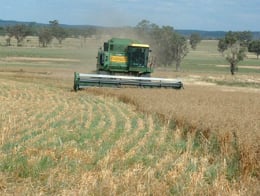 Harvesting the grain crop, showing the green and growing perennial pasture.Using the same machine, relatively small amounts of liquid organic fertiliser are added at the time of sowing, so that tractor costs and soil compaction are minimised.
Harvesting the grain crop, showing the green and growing perennial pasture.Using the same machine, relatively small amounts of liquid organic fertiliser are added at the time of sowing, so that tractor costs and soil compaction are minimised.
This vertical stacking of enterprises enables three uses of Colin’s native perennial grassland in each paddock: grain cropping (oats and wheat), grazing sheep for wool and meat, and native seed harvesting.
Wool and sheep production volumes have remained about the same as pre-1979 bushfire times, however wool tensile strength has improved markedly and vegetable matter such as burr and seed in the wool has declined significantly making both the wool and sheep more valuable.
“Importantly, while Winona now produces similar volumes of wool and grain to that achieved under previous management methods, annual costs have decreased significantly and the condition of the land is improving, not degrading,” Colin emphasised.
“It’s hard not to make money using this system!”
ROTATIONAL GRAZING
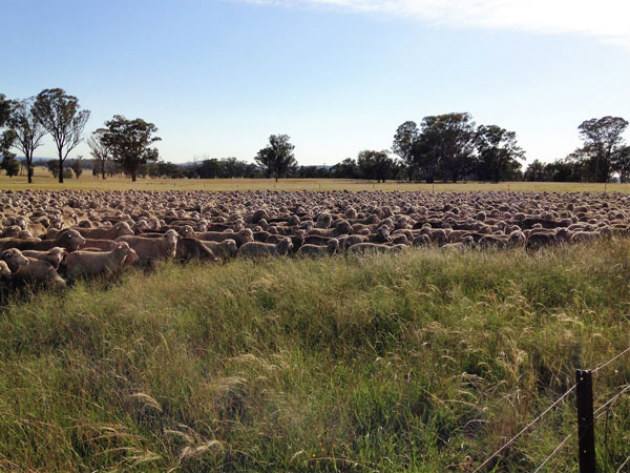
Colin’s sheep grazing the ample pasture in February 2016.
Sheep are an intrinsic part of Colin’s pasture cropping system on Winona. They are managed in two main mobs – one comprising 2,000 ewes and the other 1,500 hoggets – rotated between 70 paddocks in a time-control rotational grazing technique.
Before sowing, when perennial pasture species are dormant, short term time-control grazing with a large mob of sheep (100-150 per hectare) is used to graze and trample perennial pasture down to a height of around 100mm. This practice prepares the paddock for cropping by reducing the starting biomass and physically breaking down weeds, creating a litter and mulch layer and adding nutrients from manure and urine.
“Once the crop is harvested, sheep are reintroduced for a short period to take advantage of the native pasture that has been re-growing while the crop was maturing. Grazing-tolerant native grass species such as red grass and spear grass are gradually being replaced by more productive species such as warrego summer-grass and wallaby grass. Significant areas of winter active species such as common wheat grass and weeping grass are returning.”
Introducing time-control grazing necessitated a denser pattern of fencing to increase the number of paddocks from 10 to 70. A central laneway across the length of the property provides an efficient way to move sheep around the property.
More than 70 small dams supply stock water as there are no creeks or rivers on Winona. These dams are maintained mainly through lateral underground flow.
Colin recognises that trees provide stock with shelter and so has planted more than 2,000 single paddock trees, aiming to restore the original 1860s cover, estimated to be about two trees per hectare.
HEALTHY LAND
Overall, the implementation of pasture cropping has restored the landscape health on Winona.
The property was once dominated by annual weeds like Capeweed and Paterson’s curse, but they have been drastically reduced.
Winona is now a diverse, functioning native grassland with more than 60 native species. As Colin points out, this change was created, not with herbicides, but with groundcover.
“Providing the conditions for perennial pasture species to thrive will steadily suppress the weeds. Using herbicides can help in some circumstances but can also kill desirable species, such as the perennial pasture species.”
Tree health has improved and the remaining naturally established trees are regenerating. In addition, around 15,000 local native trees and shrubs have been planted in belts to form wildlife corridors and to link areas of remnant native vegetation.
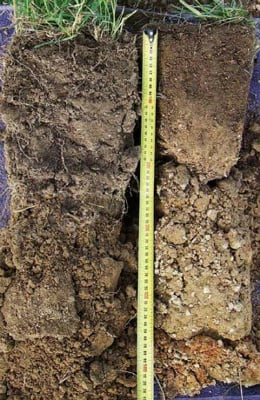 Soil from a time-controlled rotationally grazed and pasture cropped paddock (left) and from a conventionally grazed and cropped paddock (right). The soil on the left contains significantly more microbial life, soil carbon and subsequently greater water holding capacity.A large increase of spiders in pastures has delivered a more stable balance to the insect populations and provided biological control of problem insects like red legged earth mite.
Soil from a time-controlled rotationally grazed and pasture cropped paddock (left) and from a conventionally grazed and cropped paddock (right). The soil on the left contains significantly more microbial life, soil carbon and subsequently greater water holding capacity.A large increase of spiders in pastures has delivered a more stable balance to the insect populations and provided biological control of problem insects like red legged earth mite.
By applying regenerative forms of cropping and grazing, Colin has more than doubled soil carbon and significantly improved the soil water holding capacity in just ten years.
The vast majority of the soil carbon is highly stable, meaning it is significantly less susceptible to degradation, and carbon is being built and measured to a depth of 500mm.
All soil nutrients increased, including phosphorus, by an average of 172% in available and total amounts, except for aluminium, iron and sodium, which have decreased.
As well being able to pass on a productive and sustainable farm to the next generation, Colin feels a sense of achievement at having developed an innovative farming method. This method is being adopted by thousands of other farmers in similar climates and soil landscapes gloabally.
“With pasture cropping it is now possible to produce an annual crop like wheat and a perennial grain crop for human consumption off the same area within a twelve-month period. Added to this is the grazing value of sheep meat and wool as well as native grass seed, carbon sequestration and a landscape resilient to drought,” he said.






